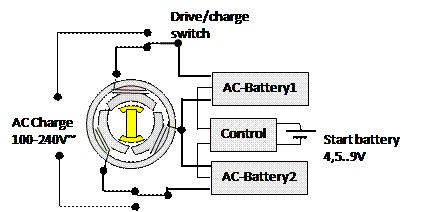Open Standards/Multipurpose AC-Battery/Application examples
With multipurpose AC batteries, it is very easy to implement chargers or drives, because the components you need are reduced to a minimum.
Most simple way to drive a motor and charge with AC
[edit | edit source]
For an e-Bike or e-Scooter, two battery packs in delta connection can drive a PMSM machine, for example. With a simple switch, the battery packs can be charged directly from 100–240 V AC grid. A simple microcontroller can control this. And, if the controller generates AC voltage without connection to a grid, it can be used as an emergency AC source...
Most simple 3-phase AC motor drive and 1-phase AC direct grid charge with 2 AC batteries. No charger, no inverter.
Motor control and 3-phase AC charge
[edit | edit source]If a 3-phase AC charge is desired (and the possible power output shall be higher), the AC battery packs can be configured in star connection. With six battery packs, charging with 1x 100–240 V or 3x 170–400 V is no problem. Recharging the 12 V starter battery, which can power lights, power steering and so on, can be done via widerange AC/DC converter.
3-phase AC motor drive and 1-phase / 3-phase AC direct grid charge with 6 AC batteries in star connection. No charger, no inverter. Widerange AC/DC converter used to recharge starter battery. Current and Voltage sensors not shown.
Motor control and 1/3-phase AC charge + solar charge
[edit | edit source]The "full version" has a multiple switch to distinguish between different charge methods and drive: One phase AC charge, three phase AC charge - and one phase DC solar charge! Using AC batteries as DC source is possible - but care must be taken that all cells are charged and discharged in the same way. A useful strategy is to step one up and step one down every second, so that the used cells rotate. In this example, an electric magnet synchronous machine is used. The advantage is, that it can deliver high torque at low speed while having the possibility of achieving high speed. This is possible by controlling the magnetic field of the rotor via PWM control. High current (~200 A) delivers high torque, low current (~20 A) reduces the induction voltage thus enabling high speed. The trick is, that for recharging the 12 V battery a B6 bridge is used which is connected to the star points of the motor winding. So the stator current recharges the battery without the need of AC/DC converters. Equipping the B6 rectifier with switches (Mos-Fets on ground side), the charge current to the battery can be switched off and thus controlled. This system requires a high sophisticated phase voltage control algorithm (phase voltage + rectifier voltage), but the system is cheap.
3-phase ESM motor drive and 1-phase / 3-phase AC direct grid charge with 6 AC-batteries in star connection. 0–1200 V DC solar charge with 6 AC-batteries in series connection. No charger, no inverter, no AC/DC converter. 6B-rectifier on star point is used to recharge 12 V.
Accelerator / decelerator pedal for smooth recuperation
[edit | edit source]The electrical drive gives the opportunity of recuperation. Very high effort is done today to get a smooth transfer from recuperative brake (from the motor, initiated via brake pedal) and mechanical break (motor + mechanical break, initiated via brake pedal). A very simple solution is the use of an "recuperative accelerator pedal", which can control both: acceleration and deceleration! So, the desired speed can easily adjusted with one foot only. The crosspoint from acceleration to deceleration is speed dependent: At low speed, there is a large range for acceleration and a small range for recuperation. At high speed, the range for recuperation is higher. (This feels like an old 1950' cadillac with 12 cylinders: lifting the foot, the motor brakes significantly.) There is no need anymore for a "smooth and expensive crossover from electrical to mechanical brake". The driver will make the crossover to mechanical break automatically if the deceleration is not sufficient, and a problem (crossover) has become a feature)
Accelerator pedal with simple transfer from drive to break, with moving neutral point dependent from the vehicle speed



